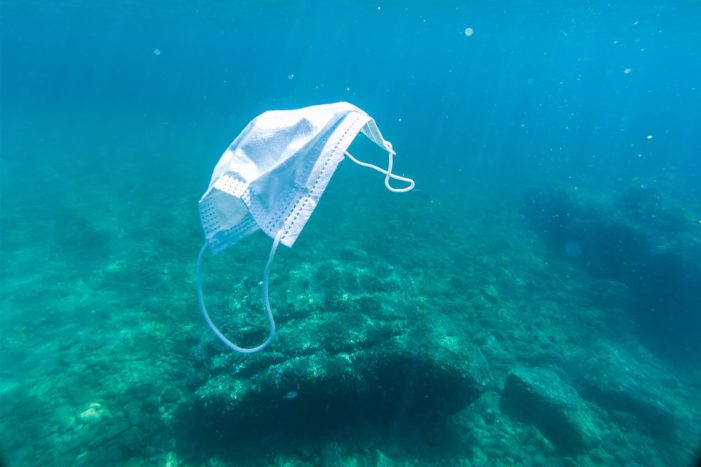Pollution from Face Mask Litter Up 9,000 Percent

A study that conducted by the University of Portsmouth and published in the journal Nature Sustainability found that facemask litter has increased by 9,000 percent in the first seven months of the pandemic, from March 2020 to October 2020.1 2 The findings show that facemasks are creating plastic pollution, which could last hundred of years and potentially increase the spread of SARS-CoV-2, the virus that causes the COVID-19 infection.3
The study’s lead researcher Dr. Keiron Roberts, professor in Sustainability and the Built Environment at the University of Portsmouth said:
Overall the study shows the impact that legislating the use of items such as masks can have on their occurrence as litter. We found that littered masks had an exponential increase from
March 2020, resulting in a more than 80-fold increase by October 2020. There is a clear need to ensure that requiring the use of these items is accompanied with education campaigns to limit their release into the environment.4
The Emergence of Personal Protective Equipment (PPE) and Plastic Syringe Pollution
According to researchers, one of the negative impacts of the COVID-19 pandemic is the emergence of a new type of plastic pollution in the form of PPE. A study conducted by University of California in San Diego and Nanjing University found that between March 2020 and August 2021, 193 countries have generated more 9.3 million tons of COVID-specific plastic waste since the pandemic began, and 28,550 tons of that ended up in the world’s oceans.5 6
The study also investigated the source of PPE pollution and found that 46 percent came from Asia, 24 percent from Europe and 22 percent from the Americas. An interesting finding was that PPE waste from hospitals accounted for 87.4 percent and PPE waste from individuals was 7.6 percent.7
In addition to PPE pollution, there is also concern about the potential waste from mass COVID-19 vaccination campaigns. Little to no progress has been made to counteract the pollution generated from the disposal of vials and syringes used for vaccination.8
Amina Schartup, PhD, assistant professor at UC San Diego’s Scripps Institution of Oceanography said:
The biggest sources of excess waste were hospitals in areas already struggling with waste management before the pandemic; they just weren’t set up to handle a situation where you have more waste.9
Looming Environmental Disaster From Facemask Pollution Clogging Sewers, Killing Plants, Animals and Humans
Researchers at the University of Portsmouth are warning government officials that pollution from facemasks can become detrimental. Steve Fletcher, PhD stated:
The majority of masks are manufactured from long-lasting plastic materials, and if discarded can persist in the environment for hundreds of years. This means they can have a number of impacts on the environment and people.10
Researchers note that the short-term consequences of facemask litter include the fact that litter acts as a potential viral vector to transmit the SARS-CoV-2 virus. When facemasks enter sewers, they can cause potential blockages where they entangle with other items causing damage to the sewer systems.11
In the long-term, facemasks can also affect the lives of animals by entangling or choking them as well as affecting plant life by smothering smaller plants and organisms. Facemask made with plastic will eventually become micro plastics in the future and have the potential to enter the food chain.12
Toxic Levels of Chemicals in Some Facemasks
Researchers have also found that many facemasks are made using toxic chemicals, particularly those manufactured in China. Some chemicals found in facemasks include dyes and heavy metals such as traces of lead, antimony and cadmium, all of which can be toxic at low levels. These heavy metals are “bio-accumulative”, which means they are not removed from aquatic systems and accumulate over time causing imbalances in the ecosystem.13
A spokesperson from the Department for Environment, Food and Rural Affairs in the United Kingdom said:
Our priority is rightly to protect public health during the ongoing coronavirus pandemic, but this does not dilute our existing commitments to tackling single-use plastics and combating litter.14
If you would like to receive an e-mail notice of the most recent articles published in The Vaccine Reaction each week, click here.
Click here to view References:
No comments:
Post a Comment